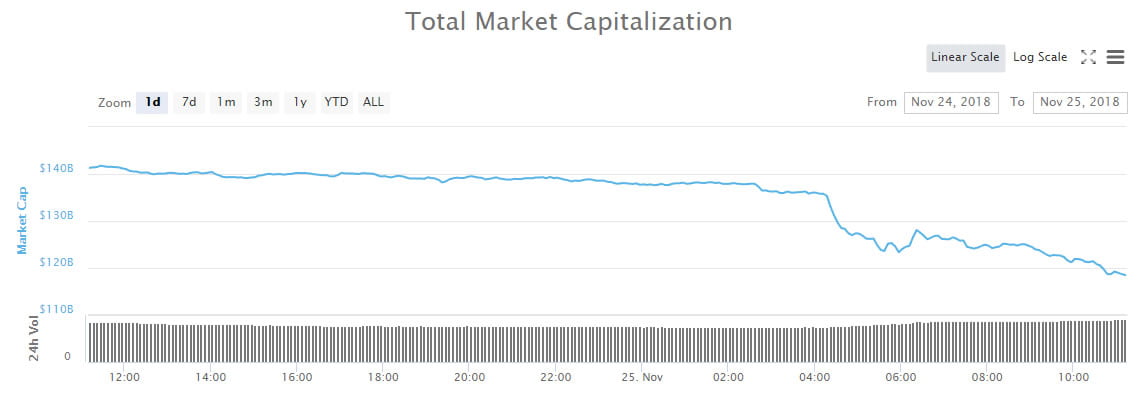
2023-9-15 16:45 |
The exodus of capital out of the cryptocurrency space over the past two years can be well summed up by examining the stablecoin market.
Given stablecoins’ central role in liquidity across the ecosystem, being the prime avenue through which investors enter and exit cryptocurrencies, the dropoff in the total supply speaks volumes. The below chart shows that the total supply is now at a two-year low, totalling $125 billion.
The market cap peaked at $188 billion prior to the Terra crisis in May 2022, meaning stablecoins on the market have dipped by a third in the last 16 months. The effect of the abrupt evaporation of the UST stablecoin can be seen clearly in the above chart. Moreover, it is also evident that that the total supply has been decreasing constantly ever since.
Beyond difficulties in the crypto space, the macro environment has been integral to the dropoff. Tight monetary policy implemented in the wake of rampant inflation means rates have risen from near-zero to above 5%.
With T-bills suddenly offering stout returns, the world’s safest investment understandably looks significantly more enticing. Concurrently, the relative attractiveness of stablecoins, and the various yield-earning products in crypto, is diminished.
Decline continues in 2023The pullback is the same all across the investment sphere. Look no further than the stock market, with the S&P 500 paring back 20% last year for its worst return since 2008. What is interesting is that the decline in the stablecoin supply has continued throughout 2023. This is despite a bounceback in risk assets, including both the stock market and crypto.
It points to other issues. At the same time that trad-fi yields have risen so sharply, we have seen the exact opposite within DeFi. Sky-high yields attracted many to the space during the pandemic, but these have proved unsustainable, exacerbating the outflow which would have already been flowing as a result of the trajectory of trad-fi rates.
Aside from Tether, which has shown remarkable resilience with its market share rising to all-time highs, the major stablecoins have all been dented. Hit “play timeline” on the below chart to see the dropoff over the last couple of years.
It should be noted that while the Terra crisis was by far the most seismic event to strike the stablecoin market, there have been other incidents in the last couple of years that have impacted the sector.
In February, the Binance-branded BUSD shut down, its New York-domiciled issuer Paxos forced to abandon minting of the coin as a result of securities laws. The winding down of BUSD has been gradual and largely non-eventful, but the loss of a major stablecoin and the greater regulatory concern was hardly a help to matters.
The world’s second-largest stablecoin, USDC, went through a more dramatic episode in March. $3.3 billion of the reserves backing the stablecoin, equivalent to 8% of the total circulating supply at the time, was held in the suddenly-collapsing Silicon Valley Bank.
Panic swept the market, with the peg dipping as low as 88 cents. Ultimately, the US administration stepped in to guarantee deposits, and the peg was swiftly restored.
While Tether has been well placed to suck up some of the capital fleeing these stablecoins, it hasn’t captured it all – the rest has simply left the space entirely.
It is the scale of the damage to the entire crypto ecosystem, as well as the struggles of DeFi, that have really led to the drawdown in the stablecoin market, rather than the aforementioned hiccups (and in crypto terms, that is all they were) for USDC and BUSD. Regulatory concerns have also not helped, and in addition to the fear sparked by the SVB incident, is a factor behind Tether’s rise in market share at the expense of USDC over the last six months (USDC is based in the US whereas USDT is European).
With the supply of stablecoins now at a two-year low, it will be interesting to track going forward. This is especially true as we near the end of the tightening cycle. Additionally, regulatory developments in recent weeks have seemed to be favourable for crypto, with Grayscale winning a landmark case against the SEC and spot Bitcoin ETFs finally seeming to be moving closer.
If crypto recovers substantially, one would expect the market cap of stablecoins to rise once more. Then again, uncertainty remains high and prices have already risen significantly this year, yet liquidity, volume and the supply of stablecoins have all been suppressed.
The post Total supply of stablecoins at two-year low amid capital exodus appeared first on Invezz.
origin »Supply Shock (M1) на Currencies.ru
|
|




